Introduction
Different art forms, such as painting, architecture, and the visual and graphic arts, have been influencing society and culture for centuries by establishing new values and serving as a repository of nations’ collective memory. Art has been supplementing historical records by providing insight into particular epochs’ social issues, crises, values, everyday situations, and deep existential questions. The ongoing commoditization of art, as well as the increasing diversity of art styles, affects modern culture to a large extent (Ekelund et al., 2017). Such tendencies have made custom creative solutions to almost any issue easily accessible, thus satisfying common individuals’ desire to highlight their uniqueness. In today’s society, with the development of new digital and manufacturing technologies, accessing art is no longer a wealthy person’s privilege, and almost everyone can enjoy it through social media or digital services. Accessibility and the freedom of choice in terms of styles and philosophies could be listed among the central trends related to art’s impact, and modern culture and society value uniqueness and free self-expression.
Art influences every aspect of life, and the workplace and workspace organization are not exceptions. This decade, the application of the artistic mode of thinking to problems in non-artistic business contexts became known to promote employees’ awareness, flexibility, and adaptability to change (Sandberg, 2019). Art therapy emerged as a separate profession in the early 1940s to reduce seriously ill patients’ psychological stress, and workplace-related applications gradually appeared (Bilgin et al., 2018). Nowadays, arts-based workplace interventions, such as coaching by artists or art therapy events for teams, are used to enhance employees’ creative thinking and strengthen their sense of innovation (Sandberg, 2019). The use of design principles, including balance, proportion, and contrast, in workspace design endeavors serves a variety of purposes, ranging from changing employees’ psycho-emotional condition to maximizing the available space’s effective use (Thoring, 2019). The right use of color, shapes, forms, or textures with reference to the workplace’s organizational peculiarities, internal processes, and tasks boosts employees’ productive mood (Thoring, 2019). Therefore, the principles of design and collaboration with professional artists can support productivity in the workplace.
Promoting Collaboration, Diversity, and Community Engagement
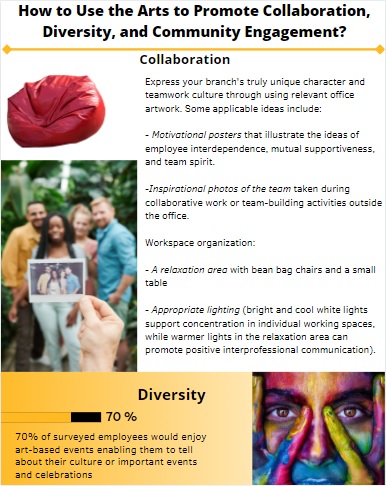
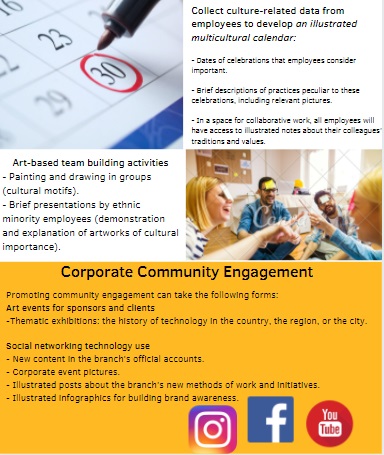
Figures 1 and 2 detail the potentially helpful uses of the arts in order to foster the spirit of collaboration and promote multiculturalism and mutual understanding between employees. The proposed practices are dissimilar in terms of required investment, with team-building events being the most affordable endeavors. To implement the plan, the employer will need a variety of resources, including the HR manager’s assistance, social media managers, content creators, and financial resources.
The Ideal Creative Workspace Proposal
Visual Model: The Five Areas
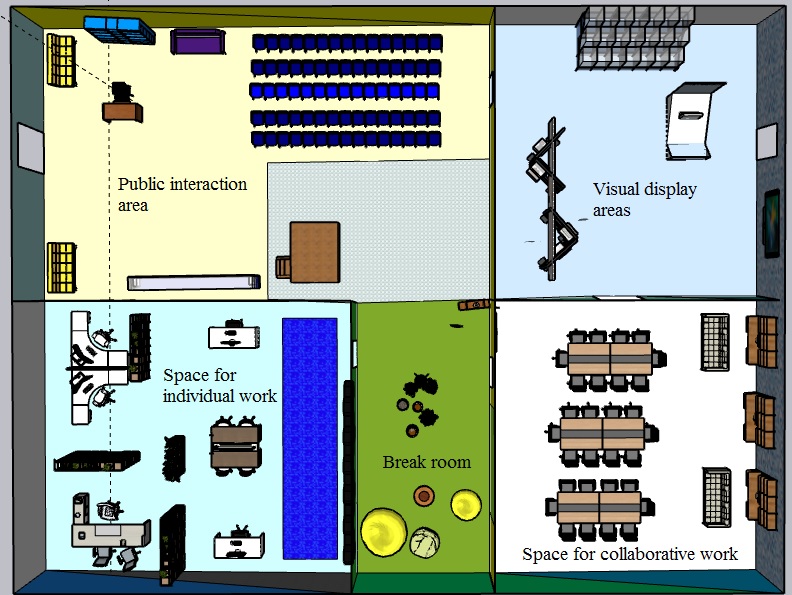
Area 1: Break Room
The first area demonstrated in figures 4 and 5 is the break room. The area will be used by any employees for relaxation purposes, but employees will have to visit it in small groups due to its size. Regarding the elements of art, this space will use colors (the shades of green and yellow) and rounded/circular shapes, whereas the design principles will be presented by emphasis and repetition (two bright yellow bean bag chairs). The room will offer a seating place for 3-4 people, a bookshelf with motivational literature and business magazines, and a small coffee table. This will encourage employees to communicate and prevent workplace burnout, thus promoting optimal creativity levels. To use the arts in this space to foster creativity and well-being, it is possible to consider peaceful landscape art for wall decoration or a self-adhesive wall drawing board to promote employees’ creative self-expression.
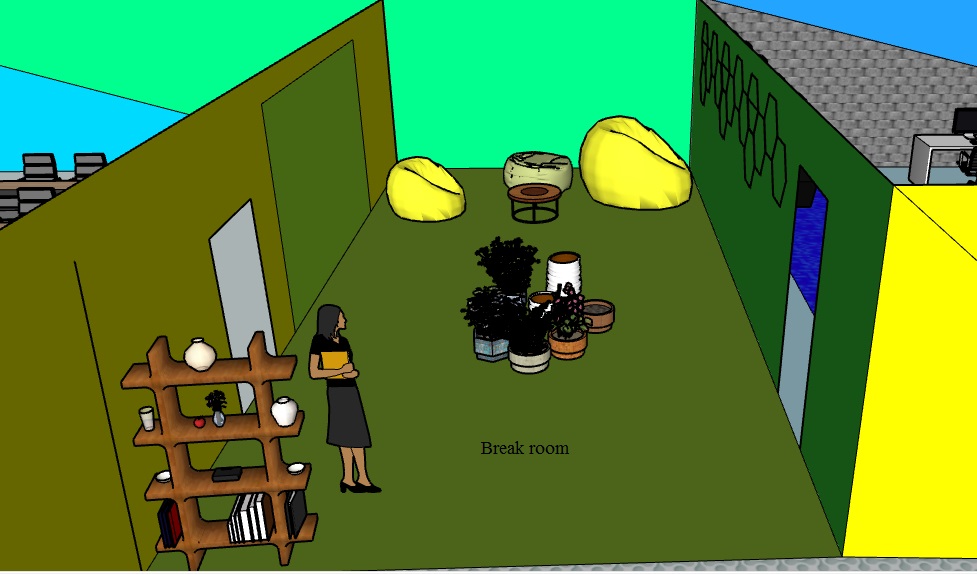
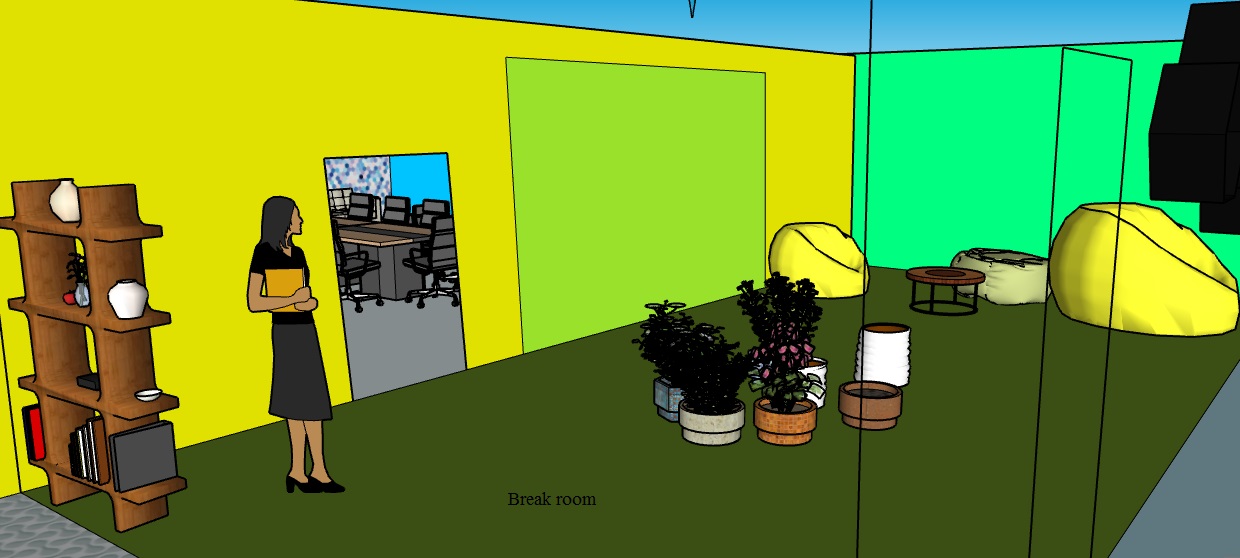
Area 2: Space for Collaborative Work
Figures 6 and 7 illustrate the second area – a space for collaborative work. This room will be used by employees at different levels of the organizational hierarchy to discuss ongoing projects, plan product and strategy development initiatives, and hold creative events for team-building. Despite the prevalence of the reserved style, the space will use diverse art elements, including color (electric blue, light blue, and light pink) and rectangular shapes. The design principles that will be present are repetition (repetitive rectangular objects), contrast (the decorated wall stands out), and movement (the blue wall’s design creates movement from left to right). For the promotion of collaboration and creativity, the space has three large tables that can be moved to suit the team’s diverse purposes and colors that inspire calmness and support productivity. As for the arts, employees will have the equipment to watch videos, films, and presentations, which will foster creativity. Similarly, employee well-being will be promoted by the multicultural calendar. Employees will be free to provide printed notes about the holidays of importance and even bring some objects (animal figurines, pictures, symbols, clothing, etc.) to illustrate their traditions.
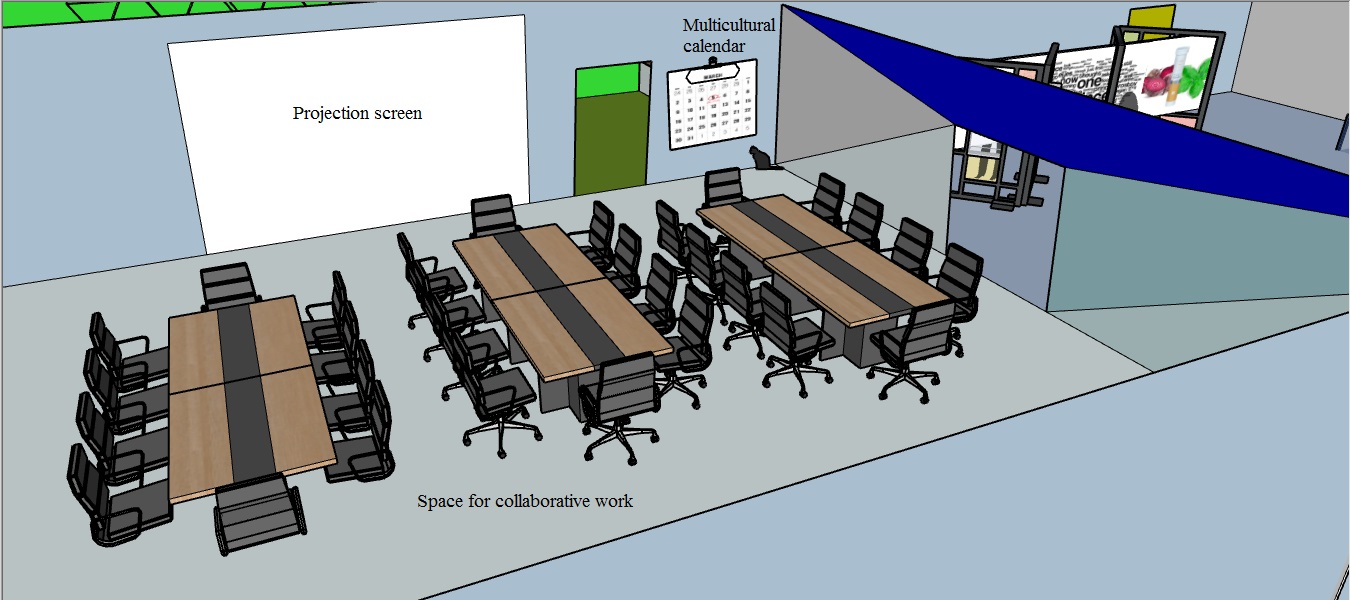
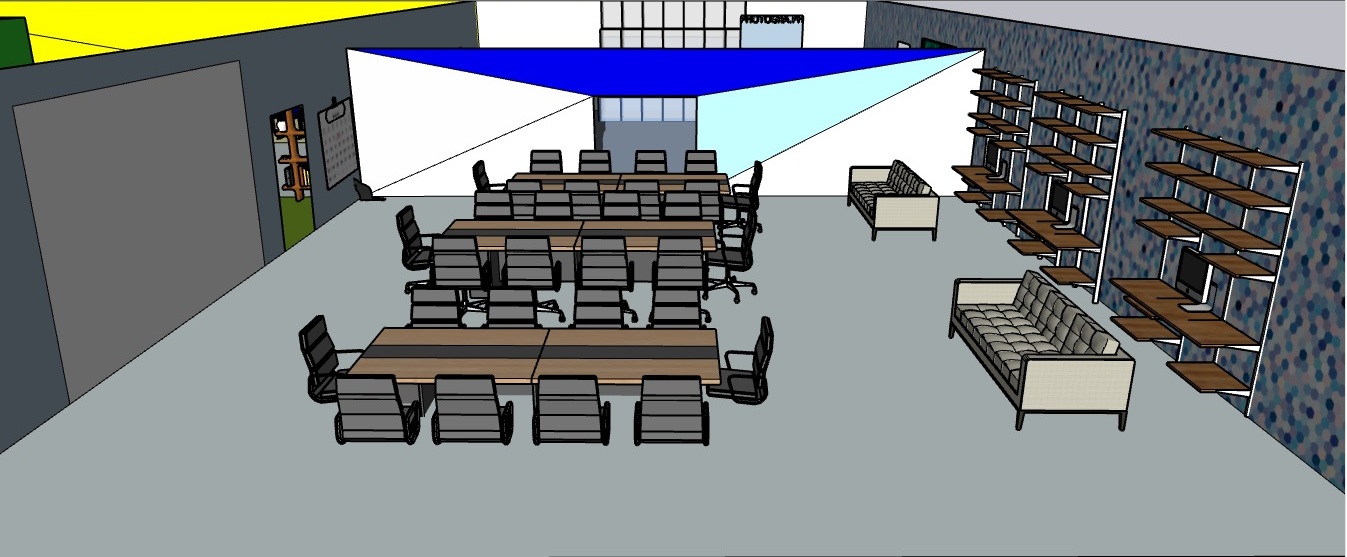
Area 3: Public Interaction Area
Figure 8 demonstrates the model of the third area – the area for public interaction. The space will be used by the branch’s customer service specialists, PR managers, and the managerial team to organize communication with individual/corporate clients, journalists, and the authorities. The space uses colors (electric blue, navy blue, light blue, yellow), rectangular shapes, and straight lines. Regarding the principles of design, the space’s uniqueness is based on the use of color contrast (complementary colors), emphasis (the third row of seats is different in color), and the repetition of yellow and blue elements in different parts of the room. The selection of furniture (the orator’s platform and seats for the audience) will foster collaboration and the exchange of ideas between the branch’s representatives and visitors. The empty space in front of the audience will create opportunities for group presentations and using various illustrative materials, thus promoting the team’s creativity. The space provides flexibility in terms of using the arts. Specifically, the space near the platform can host arts-based informational and promotional events, including freelance animators’ work and open lectures, thus promoting the team’s creative abilities and well-being.
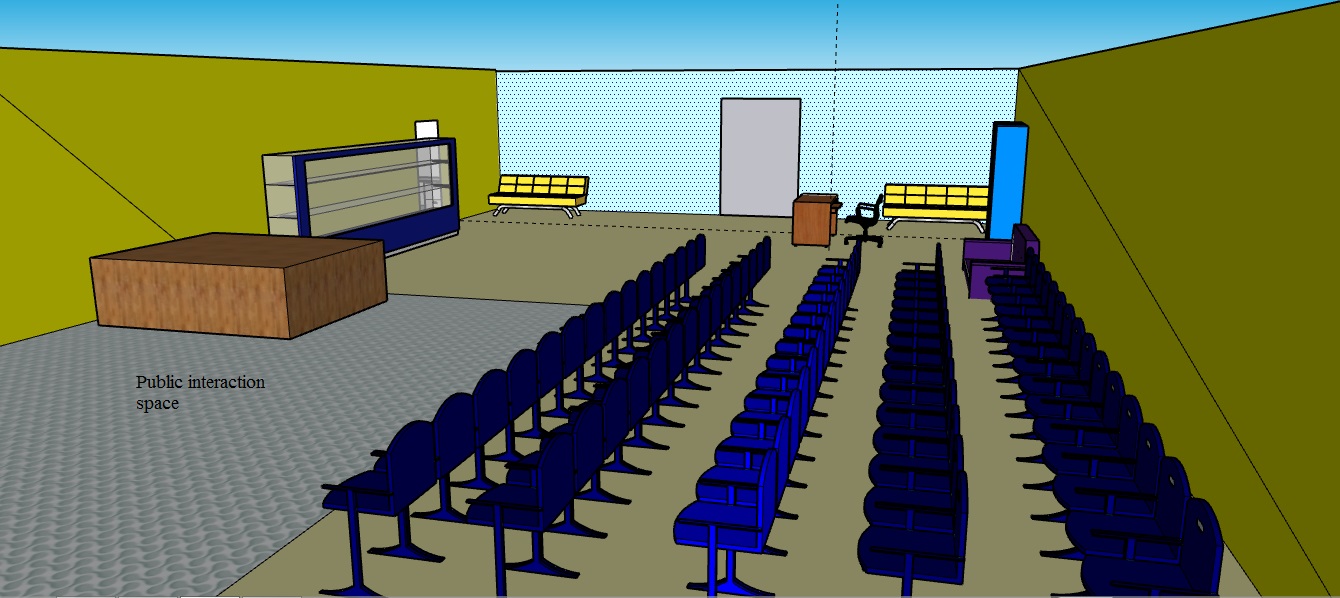
Area 4: Space for Individual Work
The fourth area is the space for individual work that will be used by the team’s non-managerial employees to perform their workplace duties. The art elements are color (grey, blue, navy blue, black), shape (square, rectangular, hexagonal), and texture (textured wallpaper). The employed principles of design include contrast (splashes of blue) and repetition (shelves and boxes with plants). With the help of shelves that divide the room into smaller areas without making employees feel isolated, the space will promote moderate solitude, retaining some opportunities for collaboration. The extensive use of plants will increase air quality, a sense of tranquility, and inspiration, thus encouraging more creative approaches to everyday tasks. The elements of visual arts, such as motivational posters selected by employees, will be put on the walls to create a sense of purpose, and the honeycomb shelves will be filled with the team’s photos. This will support well-being and creativity by promoting a friendly atmosphere.
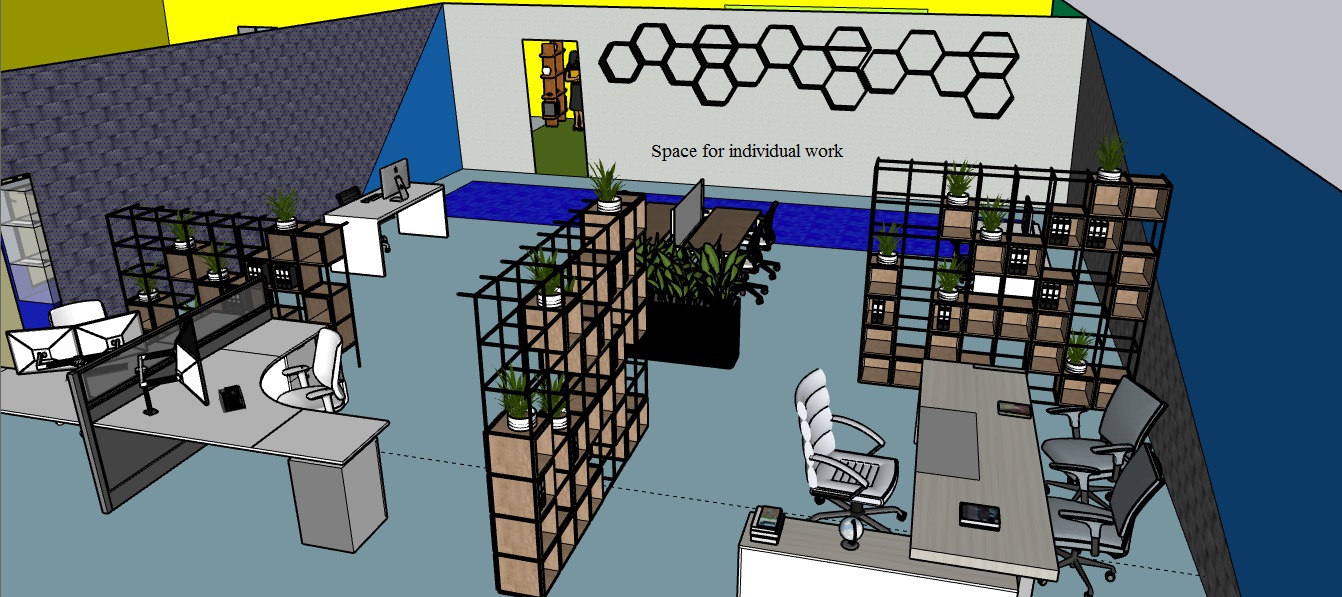
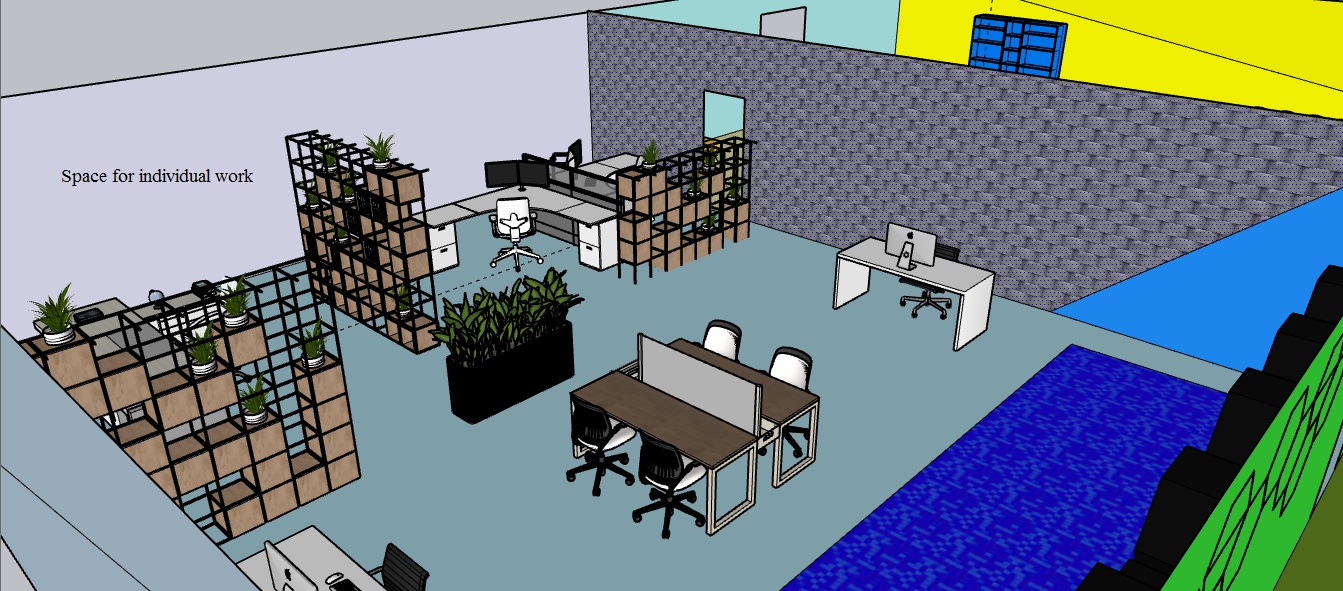
Area 5: Visual Display Areas
The fifth area shown in figures 11 and 12 will be used by customer service and PR professionals to conduct product demonstrations for the organization’s customers. In terms of art elements, the area uses colors (pink, light blue, and blue) and shapes with sharp angles. The principles of design include color contrast, some movement that draws more attention to the display on the wall, and balance that helps to create four smaller display areas that can be used independently. The need to design illustrative materials and organize small exhibitions will motivate collaboration. Also, a number of formats that the space supports (video demonstrations, photos, models, production range demonstrations, informative posters, etc.) will maximize creative freedom. In this space, the arts can be used in diverse forms, including visual art (photo exhibitions, illustrated product timelines) and music videos about technology or the company’s own films. Aside from creativity, this will enable employees to understand and communicate the value of their organization, thus promoting well-being.
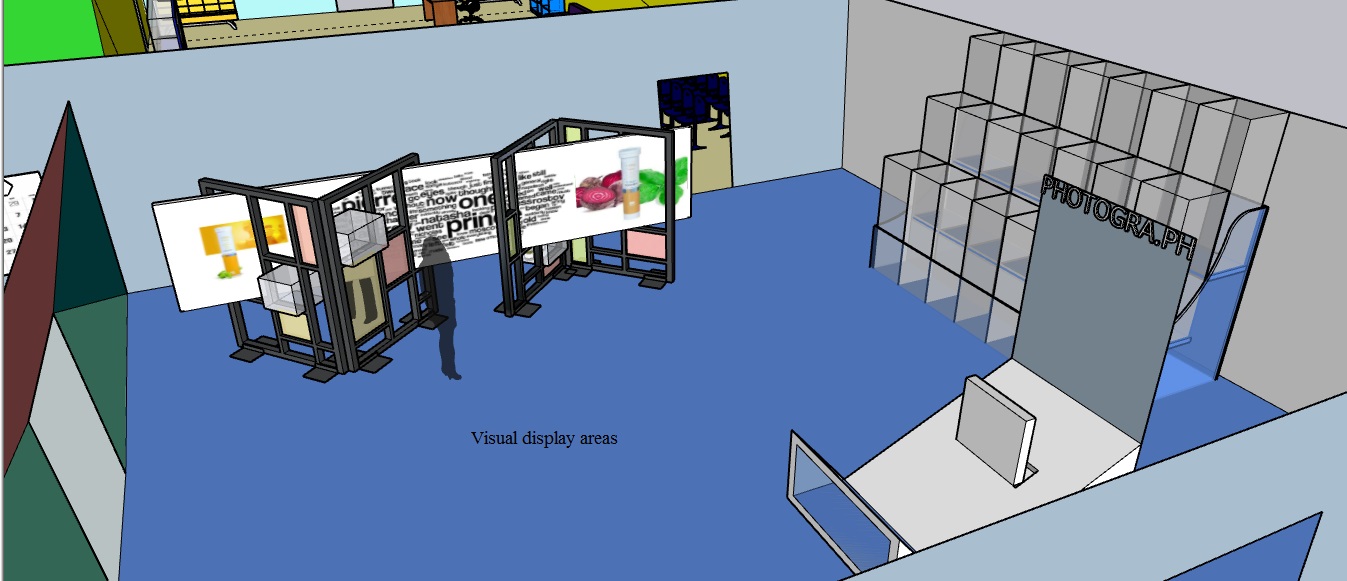
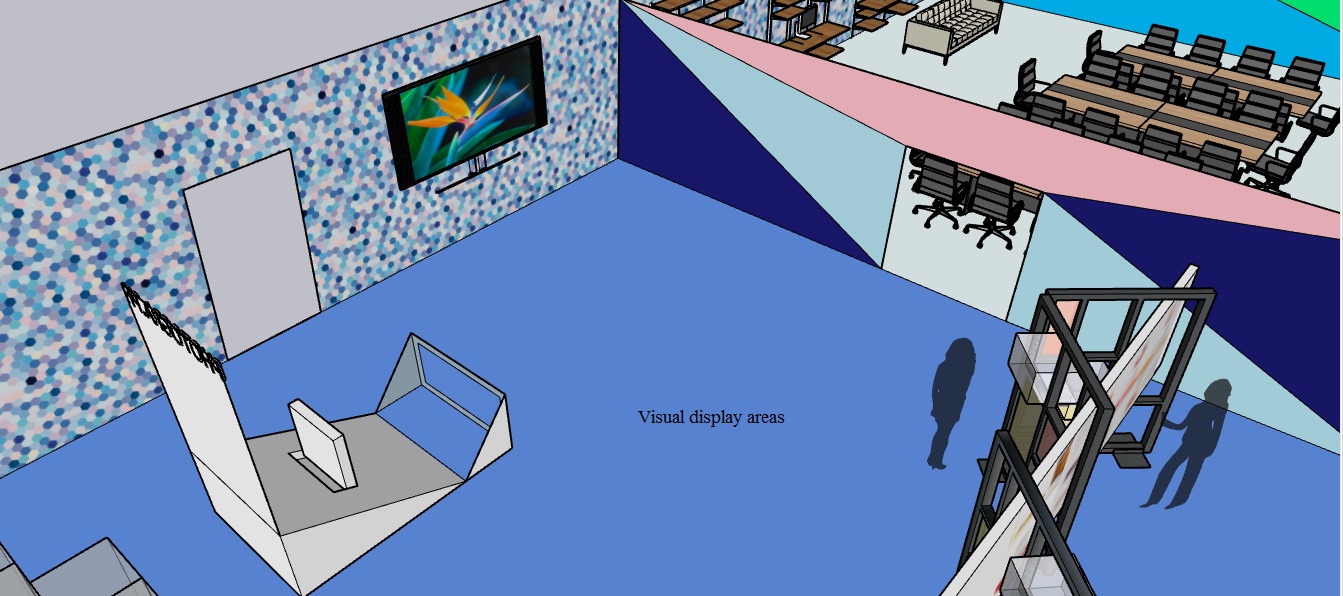
Funding Possibilities for Art Events
- Washington State Arts Commission (2019); official phone number: 360-753-3860. The association offers a grant program for organizations across Washington State. The eligible entities are non-profit art organizations, so the employer will need to collaborate with local arts/culture groups to obtain any assistance.
- National Endowment for the Arts (n.d.); address: 400 7th Street, SW, Washington, DC 20506. Similar to the previous resource, the employer can use this opportunity if the art project is to be implemented in collaboration with a non-profit or governmental organization.
- Black Artist Futures Fund (Red Olive Culture Commons, n.d.); website: www.redoliveculture.com. The organization offers financial assistance to support small Black-led arts projects and events. The employer might use this opportunity to implement a project that would have special meaning for the local Black community and employees of color.
- United Arts Funds (Americans for the Arts, n.d.); website: www.americansforthearts.org. There are forty state-level UAFs that offer financial assistance to promote arts. The employer might seek these organizations’ assistance to implement projects and events that would contribute to the city’s cultural identity.
- Indiegogo (2021); a web-based service for artists and entrepreneurs found at the following web address: www.indiegogo.com. The employer might use the service as a crowdfunding platform and raise money for diverse events, including film and web series creation, local festivals, and so on.
- Ford Foundation (2021); address: 320 E 43rd Street, New York, NY10017. This US-based organization supports the creation of movies and documentaries about social justice and equality. The employer might apply for the grant to film a documentary about multiculturalism, racial equality, and social justice in the workplace.
References
Americans for the Arts. (n.d.). United Arts Funds (UAFs). Web.
Bilgin, E., Kirca, O., & Ozdogan, M. (2018). Art therapies in cancer: A non-negligible beauty and benefit. Journal of Oncological Sciences, 4(1), 47-48. Web.
Ekelund, R. B., Jackson, J. D., & Tollison, R. D. (2017). The economics of American art: Issues, artists, and market institutions. Oxford University Press.
Ford Foundation. (2021). Our grants: JustFilms. Web.
Indiegogo. (2021). What we do. Web.
National Endowment for the Arts. (n.d.). Grants for art projects: Program description. Web.
Red Olive Culture Commons. (n.d.). Black Arts Futures Fund (BAFF). Web.
Sandberg, B. (2019). Art hacking for business innovation: An exploratory case study on applied artistic strategies. Journal of Open Innovation: Technology, Market, and Complexity, 5(1), 1-22. Web.
Thoring, K. (2019). Designing creative space: A systemic view on workspace design and its impact on the creative process (Publication No. 9789463840828) [Doctoral dissertation, Delft University of Technology]. Delft University of Technology Institutional Repository.
Washington State Arts Commission. (2019). About our grants. Web.